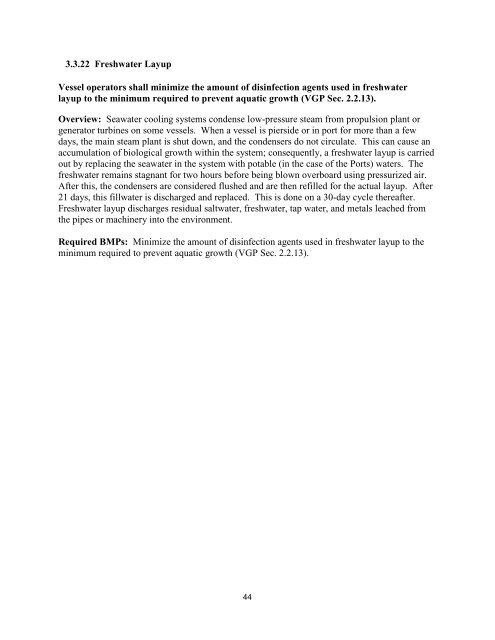Vessel Discharge Rules and Regulations - The Port of Los Angeles
Vessel Discharge Rules and Regulations - The Port of Los Angeles
Vessel Discharge Rules and Regulations - The Port of Los Angeles
Create successful ePaper yourself
Turn your PDF publications into a flip-book with our unique Google optimized e-Paper software.
3.3.22 Freshwater Layup<br />
<strong>Vessel</strong> operators shall minimize the amount <strong>of</strong> disinfection agents used in freshwater<br />
layup to the minimum required to prevent aquatic growth (VGP Sec. 2.2.13).<br />
Overview: Seawater cooling systems condense low-pressure steam from propulsion plant or<br />
generator turbines on some vessels. When a vessel is pierside or in port for more than a few<br />
days, the main steam plant is shut down, <strong>and</strong> the condensers do not circulate. This can cause an<br />
accumulation <strong>of</strong> biological growth within the system; consequently, a freshwater layup is carried<br />
out by replacing the seawater in the system with potable (in the case <strong>of</strong> the <strong>Port</strong>s) waters. <strong>The</strong><br />
freshwater remains stagnant for two hours before being blown overboard using pressurized air.<br />
After this, the condensers are considered flushed <strong>and</strong> are then refilled for the actual layup. After<br />
21 days, this fillwater is discharged <strong>and</strong> replaced. This is done on a 30-day cycle thereafter.<br />
Freshwater layup discharges residual saltwater, freshwater, tap water, <strong>and</strong> metals leached from<br />
the pipes or machinery into the environment.<br />
Required BMPs: Minimize the amount <strong>of</strong> disinfection agents used in freshwater layup to the<br />
minimum required to prevent aquatic growth (VGP Sec. 2.2.13).<br />
44

















